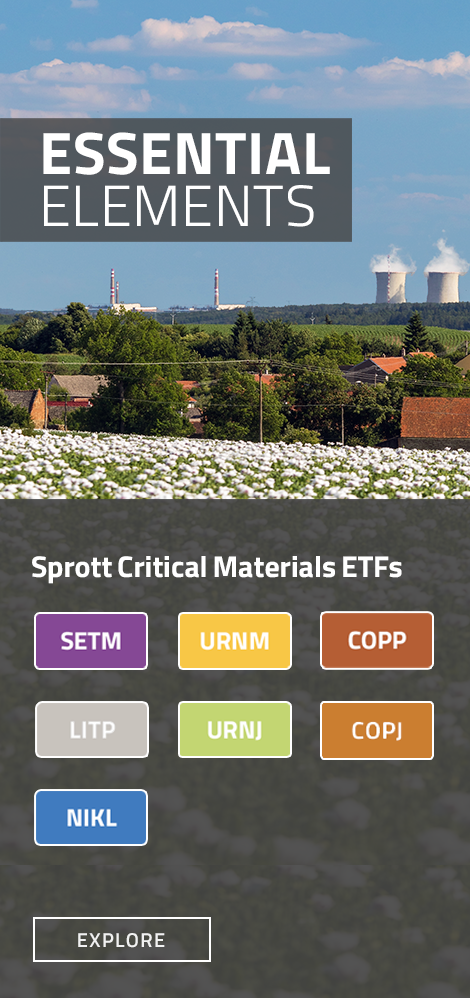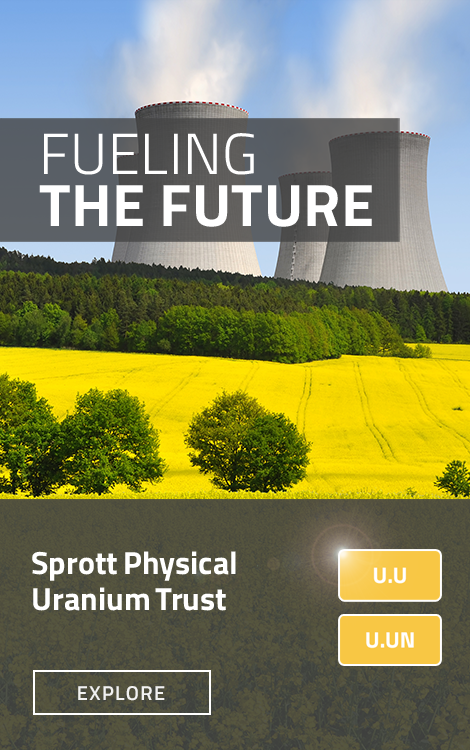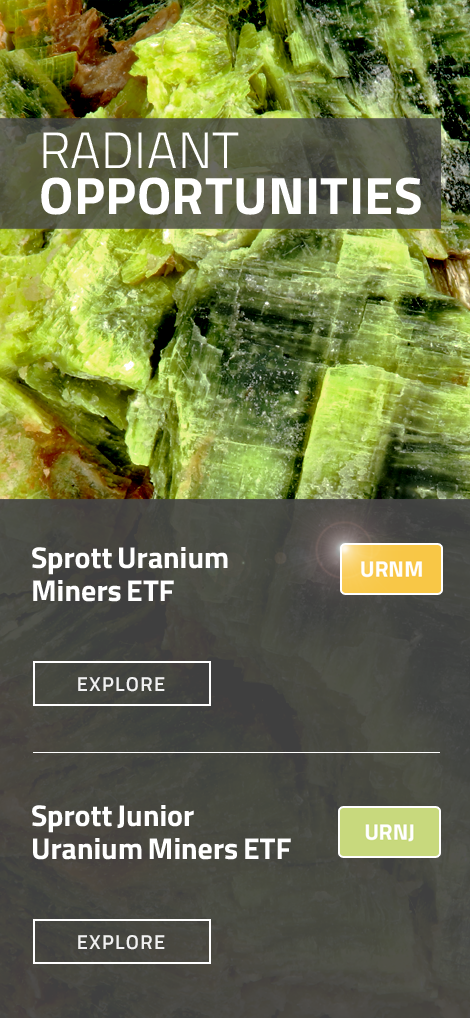Nuclear power is creating a buzz in media circles. Thalia Hayden of @etfguide talks with John Ciampaglia about the powerful comeback of nuclear energy and how tech giants are embracing nuclear energy for data centers.
For the latest standardized performance of the Sprott Energy Transition ETFs, please visit the individual website pages: SETM, LITP, URNM, URNJ, COPP, COPJ and NIKL. Past performance is no guarantee of future results.
Video Transcript
Thalia Hayden: Today, we are diving into a topic that's lighting up discussions in energy circles around the world: the powerful comeback of nuclear energy. But why now? What's changed? And more importantly, how can ETF investors and financial advisors capitalize on the nuclear power megatrend? Stick around for answers.
Welcome to Shifting Energy. I'm Thalia Hayden with ETF Guide. We're glad to have you with us. Nuclear power has created a buzz in energy circles everywhere. As nations grapple with the urgent need to cut carbon emissions and stabilize energy supplies, nuclear energy is stepping into the spotlight yet again. Even industry titans like Amazon and Microsoft are jumping into the nuclear market. But why now, what's changed, and how can investors capitalize on this? Helping us answer these questions, John Ciampaglia, CEO at Sprott Asset Management. Hi John, welcome to the program. Great to see you again.
John Ciampaglia: Good to see you. Thanks for having me. I feel like Christmas has come early for me.
Thalia Hayden: Let's get started. There are many exciting developments in the nuclear sector. Just recently, Amazon, Microsoft and Google have all announced billions of dollars of investments in nuclear energy to power data centers for AI and other processes. It almost feels like a nuclear energy arms race of sorts. So how do you see it?
John Ciampaglia: It's been an exciting last few weeks, in particular, with a wave of very interesting announcements from big tech. And they're highlighting the importance of this technology and the role they see it playing in their ambitions. And their ambitions are about an AI race as you said. It's a race going on right now. The U.S. clearly wants to be a leader in AI technology. And what everyone is quickly figuring out is that AI-related data centers are essentially big supercomputers, and these supercomputers require enormous amounts of electricity. And if you contrast a typical data center that you and I are using each day to let's say, do a Google search or put our photos in the cloud, and when you compare the amount of electricity usage for that kind of task relative to doing an AI-related task, it's 7 to 10 times more electricity intensive.
One of the key obstacles in this AI race is obviously securing clean firm power. And I'm going to focus on the term clean because these big tech companies have very aggressive carbon neutrality goals for 2030. And if you think about Microsoft or Amazon, they're obviously not producing enormous amounts of carbon, but where they're being measured is around what they call Scope 3 emissions. And that's where they are related to greenhouse gases downstream in their supply chain. And their supply chain is largely where they're generating and sourcing electricity from. So, they're very focused on clean energy and that is helping them make investments in solar and wind farms. But most recently, they've announced a flurry of deals related to nuclear energy because it's also a zero-greenhouse gas-emitting form of electricity. The second term is related to firm, and it’s jargon that refers to electricity that can be produced constantly or is also described as baseload power. And it's the opposite of intermittent power or variable power, which obviously things like wind and solar produce. So, they're very focused on clean and firm because you need to have that electricity source that is available at all times to your data center.
Thalia Hayden: Now, small modular reactors, also known as SMRs, are advanced nuclear reactors with much promise. According to the International Atomic Energy Agency, SMRs offer state-of-the-art energy solutions. How important of a role will SMRs play in the future of energy?
John Ciampaglia: They are interesting for the specific application of powering AI data centers, and we're going to see a lot more news on this. And in the last couple of weeks, we have heard from Oracle, Google and Amazon Web Services that they're all planning to help finance the construction of new small modular reactors specifically for their AI data centers. This is very exciting because this technology is still nascent. It needs funding and regulatory approval. And who better than big tech with big, deep pockets of cash to help accelerate the commercialization of this technology? And if you think about why they're rallying behind this, it's quite simple. You could build a small modular reactor, which has a very small footprint in terms of land, co-locate it right next to your AI data centers, which means build it very close by, avoid the obstacle of having to build a lot of new transmission lines, which can really get bogged down in regulatory and lawsuits, and really co-locate that power so that you've got a secure energy source. And it also ticks all the other boxes I mentioned. This is exciting because this technology has been talked about for a number of years, and we do need someone to step in and kickstart it and help get to commercial deployment.
Thalia Hayden: That makes sense. Energy security is a big concern for nations everywhere. The problem is that political tension, along with war, as we're seeing right now in the Middle East, can disrupt the supply of all important fossil fuels like oil. So how important is energy security and how can nuclear power help that?
John Ciampaglia: For energy-rich countries like Canada and the U.S., it's less of a concern. But for many countries that are highly dependent on importing things like oil and gas and coal and uranium, it has become very top of mind for these countries. They've seen how geopolitical tensions have frayed trading relationships. A number of countries are fighting right now, which is not very positive, and countries are looking to ensure they've got resilient supply chains. And it's not just things like energy; it's obviously things that we need to build in-country as opposed to relying on other countries for their manufacturing. And that's one other part of this energy story that I think is really important to highlight is that there's a lot of excitement about AI and big tech, but there's also a massive move to reshoring many critical industries that focus on semiconductors, pharmaceuticals, clean energy technology, and defense industries.
In the last few years, there have been over 800 announcements to build new manufacturing facilities in the U.S. to basically reshore many of these critical industries to the U.S. That doesn't mean we're not going to be still beholden, or reliant on other nations, but clearly, we're trying to mitigate against risks of disruption. And that's also creating a lot of low growth in the U.S. And if you look at the last 20 years in the U.S., demand for electricity has more or less been flat because engineers are very good at making things more energy efficient. But with all of these additional sources of energy demand coming to the grid, we need to make those investments in everything from small modular reactors, large reactors, and a lot of grid infrastructure, and I think this is creating a lot of excitement for investors.
Thalia Hayden: With the 2024 U.S. presidential election on everyone's mind, what impact will the outcome have on nuclear energy and the U.S. government's energy policies?
John Ciampaglia: It's a good question. We're a few weeks away from the election, and we've been getting a lot of questions from investors around how do we think the landscape may shift? Specifically for nuclear, the Biden administration has been incredibly pro-nuclear, which is not characteristic of Democratic administrations. Many of the bills, the bipartisan infrastructure bill, the Inflation Reduction Act, the Advance Act, these have all been bipartisan supported, and we don't think that there's going to be any material change one way or the other either way, depending on who wins the election. So, we think it's a continuation of ongoing support for nuclear energy. There are some elements of the nuclear fuel supply chain that we are still dependent on Russia, and that is a priority for governments right now as they're trying to reshore some of that capacity. And that's starting to happen, but we think it's continued support, which is very supportive.
Thalia Hayden: Switching gears, let's talk about uranium, which is the required fuel that keeps nuclear plants going. The World Nuclear Association estimates that by 2040, the industry will consume 300 million pounds of uranium. How much of an increase is that from today and what are uranium miners doing to prepare?
John Ciampaglia: It's an interesting question and with all of this renewed interest taking place around the world for nuclear energy in both large and small formats, a key obstacle is do we have enough fuel to power all these new builds, restarts and life extensions? And the answer is today we do not. We have a supply deficit. Today, the world only produces about 150 million pounds of uranium, and the current consumption is actually around 180 million pounds, and as you said, is gradually growing to 300 million pounds by the year 2040. It's a big challenge for the industry, but it's a huge opportunity. And those demand signals are there, the price signals are there, and the Iranian mining companies are scrambling right now to move their projects forward, expand existing mines, restart old mines, and we're starting to see a supply response. But there will be a point where all the easy stuff coming to market will be done, and then we have to do the hard stuff, which is build new mines, which hasn't been done for a long time, and that is going to require a lot of capital. The good thing is that investors are experiencing renewed interest in this thematic. And so, the uranium stocks have performed really well over the last three years. They are volatile, there's no question about it, and we saw a little bit of a slowdown over the summer. But in the last six weeks or so, the stocks have really come back to life, and we're starting to see renewed interest come back into the sector with capital flows.
Thalia Hayden: One more question, John, before you go. Getting exposure to the potential growth in uranium can be a challenge for investors. For example, popular stock market index funds often have minimal or no uranium exposure, and the same can be true of broadly diversified commodity funds. Sprott offers an investment solution. So, can you tell us about that?
John Ciampaglia: I think for the average investor, trying to pick individual mining stocks is a daunting challenge, as they just don't have the technical expertise. And I think the most popular way for typical investors to get an allocation to the space has been to take a diversified approach, buying a cross-section of different companies involved in uranium mining, and Sprott does offer an ETF that's listed in the U.S. called the Sprott Uranium Miners ETF. The ticker is URNM, which tracks an index that provides exposure to the two largest uranium miners in the world. It provides exposure to about 20% actual physical uranium through a couple of vehicles, and then a number of smaller producers, emerging producers and exploration companies. So you're kind of spreading your bets across a broad spectrum of companies. It's proven to be a very popular choice for investors, and over the last years, it is volatile. So warning, have a look at it and make sure it's appropriate for you, but it has performed very well since its inception, which is coming up to five years this December.
Thalia Hayden: Thanks so much, John, for your timely insights, and we look forward to seeing you again soon.
John Ciampaglia: Thanks for having me. It was a great chat.
Thalia Hayden: That does it for today's episode of Shifting Energy. If you enjoyed the show, please tell us in the comments section below by hitting that like button. To learn more about the investment strategies and ETFs we discussed on today's program, be sure to visit Sprottetfs.com. I'm Thalia Hayden with ETF Guide. Thanks for watching and we'll see you next time.
Important Disclosures
An investor should consider the investment objectives, risks, charges and expenses of each fund carefully before investing. To obtain a fund’s Prospectus, which contains this and other information, contact your financial professional, call 1.888.622.1813 or visit SprottETFs.com. Read the Prospectus carefully before investing.
Exchange Traded Funds (ETFs) are considered to have continuous liquidity because they allow for an individual to trade throughout the day, which may indicate higher transaction costs and result in higher taxes when fund shares are held in a taxable account.
The funds are non-diversified and can invest a greater portion of assets in securities of individual issuers, particularly those in the natural resources and/or precious metals industry, which may experience greater price volatility. Relative to other sectors, natural resources and precious metals investments have higher headline risk and are more sensitive to changes in economic data, political or regulatory events, and underlying commodity price fluctuations. Risks related to extraction, storage and liquidity should also be considered.
Shares are not individually redeemable. Investors buy and sell shares of the funds on a secondary market. Only “authorized participants” may trade directly with the fund, typically in blocks of 10,000 shares.
The Sprott Active Metals & Miners ETF, Sprott Active Gold & Silver Miners ETF and the Sprott Silver Miners & Physical Silver ETF are new and have limited operating history.
Sprott Asset Management USA, Inc. is the Investment Adviser to the Sprott ETFs. ALPS Distributors, Inc. is the Distributor for the Sprott ETFs and is a registered broker-dealer and FINRA Member. ALPS Distributors, Inc. is not affiliated with Sprott Asset Management USA, Inc.




